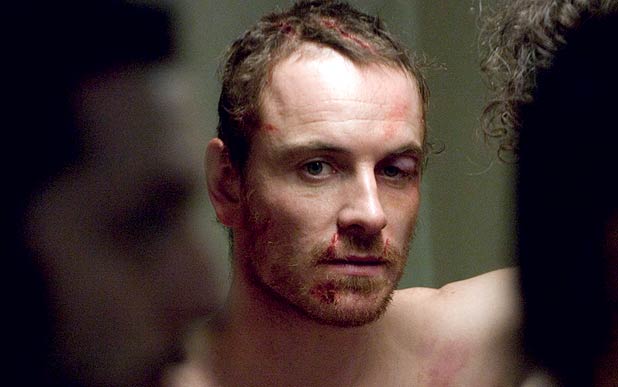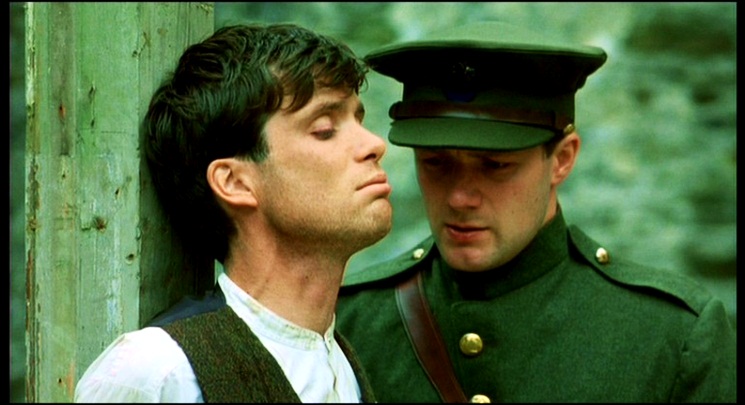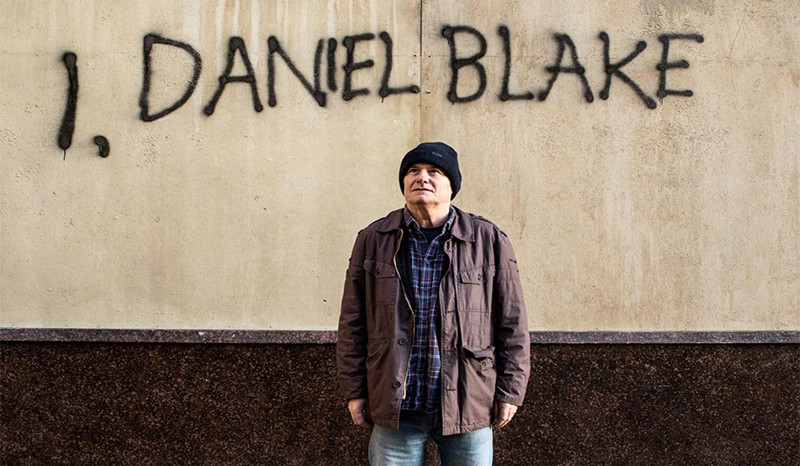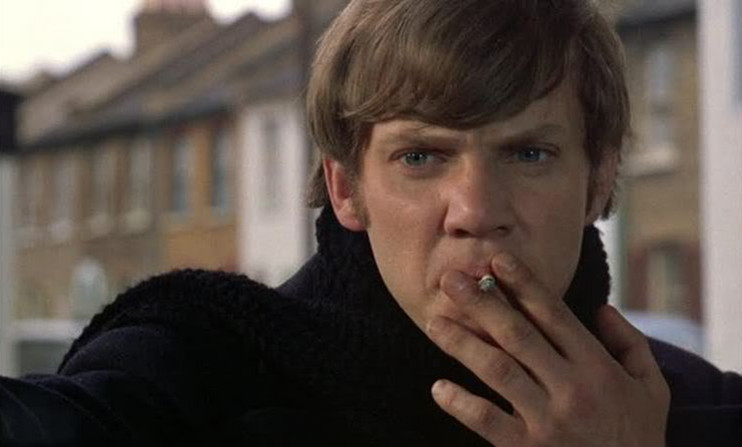5. Hunger (Steve McQueen, 2008)

Steve McQueen has proven himself a formidable 21st century filmmaker, his first film Hunger is one of the most explosive debuts in British cinema. Voted best film of 2008 by Sight & Sound magazine, the film is a modern classic which is not only aesthetically beautiful but historically important. Depicting the 1976 hunger strike of Bobby Sands, a member of the IRA, in an attempt to regain political status for Irish Republicans after it being revoked by the British government. Michael Fassbinder plays Sands in one of his most visceral performances to date, using his body as a canvas which is continually painted with dirt and blood.
The film enters this list for its brutal representation of Sands’ opposition to a cruel establishment, McQueen doesn’t condone the actions of the IRA but rather the sheer determination of its imprisoned members, who are willing to sacrifice everything for their beliefs.
The blistering critique of the prisoner’s treatment makes the audience wince from scenes of abhorrent violence and psychological torture, giving a truthful and sympathetic representation of the violence in this period. Bobby Sands and the other men participating in the strike were martyrs for their cause and the film excellently depicts this gruelling struggle.
This is especially aided by Fassbinder’s performance, from a calm and collected politician to a primal and violent prisoner in a matter of seconds, the performance really demonstrates his range as an actor.
Towards the end of the film, we see Sands, after two months of striking, try to stand by himself. In doing this, his last remaining strength diminishes, falling as soon as he stands. The scene is heart breaking and commendable as Sands refuses help from an orderly, showing that he is strong, perhaps not in body but in integrity and mind.
4. Wind That Shakes the Barley (Ken Loach, 2006)

Ken Loach’s Palme D’or winning film is yet another interesting and brutal representation of the IRA’s struggle for an independent Ireland. The film’s inclusion of the list helps to give a filmic continuity between the original IRA depicted in this film and the provisional IRA in Hunger. But of course this isn’t the only reason to include the film as it is a masterpiece in resilient cinema and historical social realism.
Showing the guerrilla warfare of the IRA against the British in 1920 to the Irish civil war in 1922, The Wind that shakes the Barley is an excellent re-telling of the struggle for the Irish Free State. The film shows the brutality of the British imperialists towards the Irish but at the same time offers a more nuanced representation of the British soldiers, who are not just faceless oppressors. It is a pure film about nationhood and the willingness to defend it, despite the costs and insurmountable odds.
The characters are willing to give up everything for their country and the belief in its independence, from Damien (Cillian Murphy) initially giving up his career as a doctor for the cause before, ultimately, giving his life. We see the power of martyrdom in a brutal but excellent scene at the beginning of the film, where an Irishman proves his contempt for the English by refusing to speak their language, instead speaking solely in Gaelic. Despite threats of violence and abuse, he refuses to speak English and is murdered by British soldiers.
The film also focuses on the story of two brothers, Damien and Teddy (Pádraic Delaney) who toward the end of the film are split between the two opposing sides of the Irish civil war. Teddy belonging to the Free State army captures the, now, Anti-IRA Damien offering him immunity if he reveals the location of a weapons store. Despite Teddy’s entreaties, Damien condemns himself to death out of loyalty to his comrades.
Loach has remarked on some of themes of the film surround the idea of ‘how to build a new society’ which adds interesting and thought provoking commentary to the film, despite fending off the imperialists with a revolution, Now what do we do? Often a question faced with revolution and The Wind that Shakes the Barley gives a compelling representation of how this is answered.
3. I, Daniel Blake (Ken Loach, 2016)

Last year’s I, Daniel Blake was certainly unmissable not only for its tough truths in representing Britain’s bureaucratic and, at times, ruthless welfare system. But, it also showed that Ken Loach still had the anger and power to emit a political discourse with news programmes and papers debating the film at length. Whether the film’s politics are entirely true is not for this article to say, however, as a piece of work I, Daniel Blake is a brilliant demonstration of how people’s personal and moral victories can outweigh political oppression.
We see this constantly throughout Loach’s work even from one of his earlier films Cathy Come Home (1966). We perceive the characters of Daniel Blake and Cathy as inspiring figures from being people who are survivors in a society that doesn’t want or care for them yet, despite this, are utterly selfless. This is especially the case of Daniel Blake who despite being in need, helps others any way he can even if it means he doesn’t eat.
This would be Loach’s second Palme d’or win as the film garnered mass critical appraise as well as public support. Like so many of Loach’s films, I, Daniel Blake doesn’t hold back on showing the grim realities for some in the U.K.
In probably one of the most heart wrenching scenes to have come out of the cinema in the last few years, we see Katie (Hayley Squires) a single mother at the mercy of the welfare system, try to steal from a foodbank where she is receiving help from. Too embarrassed to accept the help, almost living in a disbelief that she is receiving help in the first place, Katie tries stealing the food to hide her shame and prevent further deceptions. A social realist film at its most cutting.
What are so important about these films are the political messages they put across, keeping the people informed through entertainment and the establishment on their toes from criticism. With enough exposure and discussion, these kind of films can often be detrimental in changing attitudes and situations. We again have seen this historically with the aforementioned Cathy Come Home which after being screened on television helped the increase of support for homeless charities across the country.
Having two Loach films on this list is perhaps cheating to a certain extent. However, how could I not? The films I have selected only being a slither of the work he has done, only a slither of great rebellious characters too. And out of the social realist filmmakers Loach, who may not even be the best, is the most consistent who manages to make masterpiece after masterpiece. Loach, now 81, helps keep the spirit of social realism alive and his talent has never faltered. He is both an activist and an artist, for life.
2. The Draughtsman’s Contract (Peter Greenaway, 1986)

Peter Greenaway’s debut film is a must for British cinema fans, with its gorgeous framing and design, eccentric characters and an excellent soundtrack by Greenaway regular Michael Nyman, the film is a classic. Set in 1694 Wiltshire, the film follows the exploits of the young artist, Mr Neville (Anthony Higgins) as he paints several pictures of a manor house in exchange for the lady of the house’s sexual pleasure. The film soon turns into a murder mystery, with questions left unanswered and more proposed.
This film is perhaps quite an odd addition to this list as revolution isn’t particularly a theme of the film or even mentioned. However, what is interesting about The Draughtman’s Contract is Neville’s disregard for the rigid class structures of England, rebelling against class consciousness and morals to get what he wants. Neville will quite happily insult and humiliate the pompous Mr, Tallman as well as sexually degrade Mrs, Herbert.
Some of the most enjoyable moments in the film are the constant power struggles of the residents of the house, all believing they are in charge before being replaced. However, despite Neville’s assuming power of the household, it is soon revealed that it was nothing but a ruse as we learn he has been a powerless pawn the entire time. The film excellently shows the underclass’s struggle for power and the difficulty of this in the face of a scheming and intelligent ruling class.
Perhaps this is not a straight toward inclusion to a list on revolution and rebellion, but what British film list is without a mention of Greenaway? Whose film’s narratives don’t focus on revolutionary struggle but rather revolution in cinematic form with their baroque design, synergising painting and cinema. Greenaway himself is a revolutionary figure, not succumbing to commercial filmmaking but instead maintaining a level of artistic integrity at its most candid.
1. If… (Lindsay Anderson, 1968)

The first of Lindsay Anderson’s Mick Travis ‘trilogy’ and a quintessential film of the 60s counterculture, If…, is stunning critique of the archaic and boisterous English boarding school system. Malcom McDowell is the fresh faced Michael Travis who, with elements of Richard Lester’s Billy Liar (1963), daydreams his way out of conformity instead seeking his own ideological freedom in the face of an elitist and oppressive hegemony.
Not only is the film evidence of social revolution, with Travis and his friends trying to break the social norms of the school with their strange activities and their revolutionary posters, including portraits of Lenin, Che Guevara and Geronimo. But they also embark on a sexual revolution from meeting with young women in cafes to plastering pin ups in their study’s walls and lustfully kissing them. The gang detach themselves from the other sexually repressed students who would rather go to a priest for advice on ‘dirty thoughts’.
The film is, in part, influenced by Jean Vigo’s short Zero de conduite (1933), which like If… contains surrealistic and anarchistic sequences. Zero De Conduite is in black and white but if…differs between colour and B&W to give a sense of the student’s freedom/confinement.
The black and white sequences showing the control of the school, whether they be at church, regimented exercise lessons, or controlled bed times. As well as in a sequence where a young student looks forlornly at another whilst at the gym, building homoerotic tension, tension that can never be released.
The film’s ending is one of the most iconic in cinema history as the boys find a cache of weapons, taking them to the roof and gunning down pupils, parents and teachers. It is a somewhat surreal scene and it is uncertain whether it happens or not.
However, it operates as an allegory for the release of pressure upon the hormonal, confused and repressed young men. Anderson would make an unofficial trilogy with McDowell followed by O Lucky Man (1973) and Britannia Hospital (1982) which equally challenged and critiqued the establishment, but these perhaps lacked the punch of If…
Author Bio: Laurence Smither is an undergraduate at Royal Holloway University London while also a free-lance writer and reader. Interested in Literature, German New Wave and British Cinema, Laurence is currently writing his dissertation on the BBC’s Threads and The War Game.